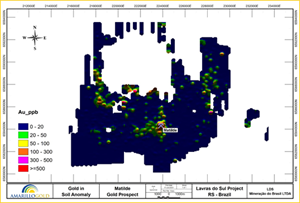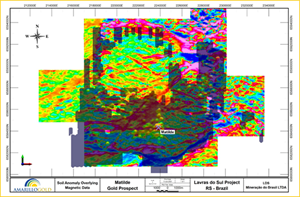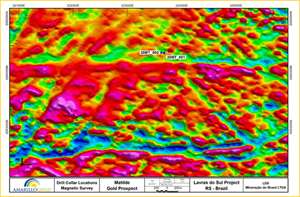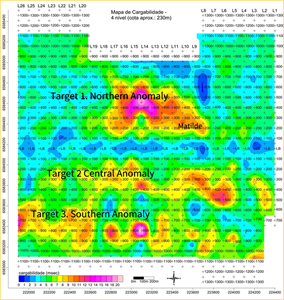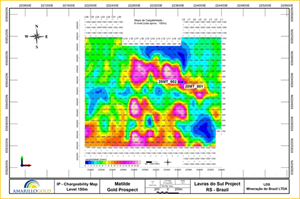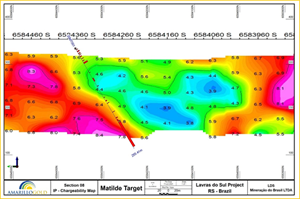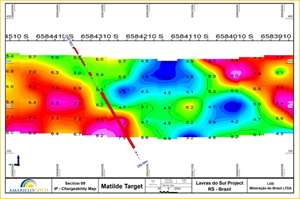Amarillo drills 144.6 m of 0.7 g/t gold including 91.6 m at 0.9 g/t gold at LDS
TORONTO, June 23, 2021 (GLOBE NEWSWIRE) -- Amarillo Gold Corporation (TSXV: AGC, OTCQB: AGCBF), through its Brazilian affiliate, has drilled a significant gold-hosting structural zone on Lavras do Sul (LDS), the Company’s property in Rio Grande do Sul, southern Brazil.
Two holes located 50 metres apart along an east-west strike direction were drilled into the Matilde target, confirming the primary source of gold of an overlying gold-in-soil anomaly. The target was identified through a combination of soil geochemistry, geological mapping, surface trenching, and airborne magnetics. A recently completed ground induced polarization survey also helped define a structural corridor that is now being drill tested.
Wide intervals of gold mineralization were intersected from surface in both holes (Table 1):
- Hole 20MT_001 intersected 62.53 metres grading 0.62 grams per tonne (g/t) gold from 189.70 metres including 12.77 metres grading 0.89 g/t gold from 191.48 metres and 14 metres grading 1.13 g/t gold from 228.40 metres.
- Hole 20MT_002 intersected 144.60 metres grading 0.69 g/t gold from 117.00 metres including 91.60 metres grading 0.87 g/t gold from 170.00 metres and 9.00 metres grading 1.02 g/t gold from 172.00 metres and 27.00 metres grading 1.04 g/t gold from 184.00 metres.
There are numerous zones of elevated gold values beginning from surface throughout both holes.
“These holes are significant intersections that confirm the primary source of gold at Matilde,” said Mike Mutchler, Amarillo’s President and Chief Executive Officer. “Gold mineralization begins at surface and shows good continuity over broad intervals and across a wide structural corridor.”
TABLE 1: SIGNIFICANT DRILL INTERSECTS FROM HOLE 20MT_001 AND 20MT_002
| 20MT_001 | From (metre) | To (metre) | Interval (metre) | Gold (g/t) | 20MT_002 | From (metre) | To (metre) | Interval (metre) | Gold (g/t) | |
| 3.00 | 4.00 | 1.00 | 0.57 | 0.00 | 18.00 | 18.00 | 0.43 | |||
| 7.00 | 9.28 | 2.28 | 0.70 | including | 2.00 | 6.00 | 4.00 | 0.70 | ||
| 12.33 | 14.08 | 1.75 | 0.63 | including | 13.00 | 15.00 | 2.00 | 0.76 | ||
| 16.00 | 17.00 | 1.00 | 0.66 | 23.00 | 24.00 | 1.00 | 0.44 | |||
| 20.00 | 22.00 | 2.00 | 0.52 | 29.39 | 48.00 | 18.61 | 0.40 | |||
| 26.00 | 27.00 | 1.00 | 0.74 | including | 29.39 | 36.39 | 7.00 | 0.72 | ||
| 31.09 | 32.23 | 1.14 | 0.59 | 65.00 | 74.00 | 9.00 | 0.57 | |||
| 35.70 | 38.83 | 3.13 | 1.20 | including | 68.00 | 74.00 | 6.00 | 0.70 | ||
| 61.45 | 62.18 | 0.73 | 0.37 | 79.00 | 80.00 | 1.00 | 0.34 | |||
| 76.00 | 84.00 | 8.00 | 0.30 | 102.00 | 103.00 | 1.00 | 0.33 | |||
| 96.00 | 97.00 | 1.00 | 0.51 | 109.90 | 110.67 | 0.77 | 0.36 | |||
| 125.00 | 126.00 | 1.00 | 0.40 | 117.00 | 261.60 | 144.60 | 0.69 | |||
| 132.82 | 135.00 | 2.18 | 0.40 | including | 117.00 | 121.00 | 4.00 | 0.75 | ||
| 139.73 | 140.73 | 1.00 | 0.66 | including | 146.00 | 152.00 | 6.00 | 0.81 | ||
| 162.65 | 163.41 | 0.76 | 0.77 | including | 170.00 | 261.60 | 91.60 | 0.87 | ||
| 177.00 | 178.80 | 1.80 | 0.58 | including | 172.00 | 181.00 | 9.00 | 1.02 | ||
| 181.86 | 184.62 | 2.76 | 0.33 | including | 184.00 | 211.00 | 27.00 | 1.04 | ||
| 189.70 | 252.23 | 62.53 | 0.62 | including | 214.00 | 218.00 | 4.00 | 0.85 | ||
| including | 191.48 | 204.25 | 12.77 | 0.89 | including | 230.00 | 232.00 | 2.00 | 0.97 | |
| including | 207.00 | 211.87 | 4.87 | 0.69 | including | 234.00 | 236.60 | 2.60 | 1.16 | |
| including | 228.40 | 242.40 | 14.00 | 1.13 |
Notes:
- True widths have not been determined at this time. Length-weighted intervals are uncapped and calculated based on a 0.2 g/t gold cut-off and a maximum internal dilution of 4.00 metres
- Drill collar coordinates for 20MT_001 – Easting: 223679, Northing: 6584363, Dip: -60, Azimuth: 180
- Drill collar coordinates for 20MT_002 – Easting: 223629, Northing: 658369, Dip: -60, Azimuth: 180
Overview
Gold mineralization at LDS is hosted within the Lavras granite complex, an intrusive that has a 10-kilometre diameter.
These assay results are from the first two holes of a drilling program that targeted Matilde, which is located about 3 kilometres south of the town of Lavras do Sul (Figure 1).
A 6,000-metre drilling program is currently underway at Matilde out of an overall 8,000-metre program at LDS. The program at Matilde is testing targets along strike of the known mineralization to depths generally from 150 to 300 metres.
As highlighted in Figure 2, the Matilde target includes a gold-in-soil anomaly that extends over 3.5 kilometres in an east-west strike direction and 3.5 kilometres in a north-south strike direction located in the south-central portion of the intrusion.
Figure 3 illustrates the Matilde soil anomaly superimposed over airborne magnetic data. The airborne magnetic data highlights differences in the magnetic properties of rock types and is useful in highlighting major structural trends or faults. The data suggests that the Matilde region is structurally complex and characterized by major north-west, east-west, and north-east trending faults.
Figure 4 is a magnified image of the magnetic data that shows the location of holes 20MT_001 and 20MT_002 relative to structural trends. Gold mineralization discovered in these two holes appears to occur at the intersection of three structures: a northwest trending fault, a northeast trending fault, and a major east-west structural corridor. Intersecting structures (or faults) are therefore considered primary exploration targets.
Figure 5 shows a plan view of a recently completed 63 line kilometre ground induced polarization survey at Matilde that has identified three major east-west chargeability anomalies at a depth of 230 metres below surface: the Northern Anomaly (Target 1), the Central Anomaly (Target 2), and the Southern Anomaly (Target 3). These anomalies are interpreted as potentially favourable east-west structural corridors for hosting gold mineralization.
Gold associated with drill holes 20MT_001 and 20MT_002 occurs within the Northern Anomaly (Target 1).
Figure 6 is a plan view showing the location of drill holes 20MT_001 and 20MT_002 relative to chargeability anomalies derived from the recently completed surface IP survey at the 150-metre level. The holes tested the east-west strike extent of mineralization and were drilled from north to south with an azimuth of 180 degrees.
Figure 7 shows an east-facing cross section of drill hole 20MT_001 relative to the chargeability anomaly.
Figure 8 shows an east-facing cross-section of drill hole 20MT_002 relative to the chargeability anomaly. Elevated gold values appear to occur at the transition from low chargeability to high chargeability zones.
The drilling program also includes testing targets in the Central Anomaly (Target 2) and Southern Anomaly (Target 3) structural corridors. Future drilling results will be released as the program unfolds.
DRILL HOLE 20MT_001
Drill hole 20MT_001 was designed to test an east-west trending structure directly below a gold in soil anomaly and adjacent to a surface trench that confirmed significant hydrothermal alteration and elevated gold values.
The drill hole was collared north of the interpreted east-west trending structure with an azimuth of 180 degrees. The hole was angled at 60 degrees and drilled to a total depth of 255.41 metres.
Seventeen elevated gold intervals were encountered between 3 metres and 185.62 metres down the hole having gold intercepts ranging from 0.3 to 1.20 g/t gold over widths ranging from 0.73 metres to 8.00 metres (see Table 1 and Appendix 1).
A 62.53-metre continuous intercept of gold mineralization was then encountered from 189.70 metres to 252.23 metres having a length-weighed average grade of 0.62 g/t Au and containing several higher-grade gold subintervals including:
- 12.77 metres grading 0.89 g/t gold from 191.48 metres
- 4.87 metres grading 0.69 g/t gold from 207.00 metres
- 14.0 metres grading 1.13 g/t gold from 228.40 metres.
The original host rock is interpreted to be granodiorite that had been variably hydrothermally altered throughout the drill core. Zones of elevated gold typically are associated with hydrothermal breccia characterized by areas of intense silicification, sericite (phengite), chlorite, albite, hematite, 2-3% disseminated pyrite, and trace amounts of galena and chalcopyrite (see Appendix 3: Photos).
Generally, elevated gold values are also associated with anomalous values of arsenic, bismuth, and copper.
DRILL HOLE 20MT_002
Drill hole 20MT_002 was collared 50 metres west of 20MT_001 and was designed to test the western strike extension of gold mineralization.
The hole was collared north of the interpreted east-west trending structure with an azimuth of 180 degrees. The hole was angled at 60 degrees and drilled to a total depth of 289.09 metres.
Seven intervals of elevated gold values were encountered between 2.00 metres and 110.67 metres ranging from 0.33 g/t gold to 0.57 g/t gold over lengths of 0.77 metres to 17.81 metres (see Table 1 and Appendix 2).
Next a 144.60-metre intercept of gold mineralization from 117.0 metres to 261.60 metres having a length-weighted average grade of 0.69 g/t gold was also encountered (see Table 1 and Appendix 2). Several higher-grade intervals were encountered within this long intercept including:
- 91.60 metres grading 0.87 g/t gold
- 9.00 metres grading 1.02 g/t gold
- 27.00 metres grading 1.04 g/t gold.
Like hole 20MT_001, the original granodiorite intrusive rocks show the same alteration and mineral associations throughout the drill core. Zones of higher gold values typically are associated with hydrothermal breccia with areas of intense silicification, sericite (phengite), chlorite, albite, hematite, 2-3% disseminated pyrite, and trace amounts of galena and chalcopyrite (see Appendix 3: Photos).
Generally, zones of elevated gold values are associated with anomalous values of arsenic, bismuth, and copper.
A complete list of assay sample results for the 20MT_001 and 20MT_002 intersections is provided in Appendices 1 and 2.
Appendix 3 shows photos of typical styles of mineralization found at Matilde.
Figures
FIGURE 1: PLAN VIEW SHOWING DRILL COLLAR LOCATIONS FOR HOLES 20MT_001 AND 20MT_002 AT MATILDE is available at https://www.globenewswire.com/NewsRoom/AttachmentNg/d9f162f4-61f2-415e-878a-a1e2c4fd6896
FIGURE 2: MATILDE PROSPECT – GOLD IN SOIL ANOMALY is available at https://www.globenewswire.com/NewsRoom/AttachmentNg/18ac8d1d-8d16-47ea-8e54-3f773c08374a
FIGURE 3: MATILDE SOIL ANOMALY OVERLYING MAGNETIC DATA is available at https://www.globenewswire.com/NewsRoom/AttachmentNg/4e3933fe-0616-4d49-a93e-e255759c97e2
FIGURE 4: LOCATION OF DRILL HOLES 20MT_001 AND 20MT_002 RELATIVE TO MAGNETIC DATA is available at https://www.globenewswire.com/NewsRoom/AttachmentNg/13052526-fa47-4e92-8eb6-f7f5496b7e02
FIGURE 5: PLAN VIEW OF CHARGEABILITY ANOMALIES AT MATILDE AT 230 M LEVEL is available at https://www.globenewswire.com/NewsRoom/AttachmentNg/8f00f11f-436e-4922-bc47-900b4b51e5b9
FIGURE 6: PLAN VIEW OF LOCATION OF DRILL HOLES 20MT_001 AND 20MT_002 RELATIVE TO CHARGEABILITY ANOMALY is available at https://www.globenewswire.com/NewsRoom/AttachmentNg/4a563600-cf33-4eaa-85a9-b8eea01f9c22
FIGURE 7: EAST-FACING CROSS SECTION OF DRILL HOLE 20MT_001 RELATIVE TO CHARGEABILITY ANOMALY is available at https://www.globenewswire.com/NewsRoom/AttachmentNg/2cc10b42-5b6e-4471-b469-6d49435ed18a
FIGURE 8: EAST-FACING CROSS-SECTION OF DRILL HOLE 20MT_002 is available at https://www.globenewswire.com/NewsRoom/AttachmentNg/b6d0562d-6860-4ccf-8e3b-7fc6d304c26b
Qualified person
Michael Durose, P.Geo., Consulting Geologist for Amarillo Gold Corporation and a qualified person (QP) as defined by Canadian National Instrument 43-101, has reviewed and approved the scientific and technical information contained in this release.
Quality assurance and quality control
Sample handling, preparation, and analysis are monitored through the implementation of formal chain-of-custody procedures and quality assurance/quality control programs designed to follow industry best practices.
All drill hole samples in this drilling program consist of split NQ diamond drill core.
Drill core is logged and sampled in a secure facility located in Lavras do Sul, Rio Grande do Sul State, Brazil. Drill core samples for gold assay are cut in half using a diamond saw and submitted to ALS Laboratories Inc. in Goiania, Goiás State, Brazil for preparation by crushing to 70% passing 2.0 mm, riffle splitting to obtain 500 g aliquots, and pulverizing to 85% passing 75 microns.
Pulps are shipped to ALS Laboratories in Lima, Peru and analyzed by a 30 g fire assay and AAS finish. For assays above 10 ppm gold, a cut of the original pulp was re-assayed with a gravimetric finish.
Certified standards, non-certified blanks and field duplicates are inserted into the sample stream at regular intervals, so that QA/QC accounted for about 10% of the total samples. Results are routinely evaluated for accuracy, precision, and contamination.
About Amarillo
Amarillo is advancing two gold projects located near excellent infrastructure in mining-friendly states in Brazil.
The development stage Posse Gold Project is on the Company’s Mara Rosa Property in Goiás State. It has a positive definitive feasibility study that shows it can be built into a profitable operation with low costs and a strong financial return. Mara Rosa also shows the potential for discovering additional near-surface deposits that will extend Posse’s mine life beyond its initial 10 years. The exploration stage Lavras do Sul Project in Rio Grande do Sul State has more than 23 prospects centered on historic gold workings.
Amarillo trades on the TSXV under the symbol AGC and the OTCQB under the symbol AGCBF. Visit www.amarillogold.com to learn more about the Company’s focus on becoming a mid-tier Brazilian gold producer.
Follow us on LinkedIn, Twitter, and YouTube.
Contact information
| Mike Mutchler President & CEO 416-294-0736 mike.mutchler@amarillogold.com | Annemarie Brissenden Investor Relations 416-844-6284 annemarie.brissenden@amarillogold.com | |
NOTES
Neither the TSX Venture Exchange nor its Regulation Services Provider (as defined in the policies of the TSX Venture Exchange) accepts responsibility for the adequacy or accuracy of the content of this news release.
Forward-looking statements
This news release contains forward-looking statements regarding the Company’s current expectations regarding future events, including its business, operations and condition, and management’s objectives, strategies, beliefs, and intentions.
Various factors may prevent or delay our plans, including but not limited to, the trading price of the common shares of the Company, capital market conditions, impacts from the coronavirus or other epidemics, counterparty risk, TSXV approval(s), contractor availability and performance, weather, access, mineral and gold prices, and success and failure of the exploration and development carried out at various stages of the program. Permission from the government and community is also required to proceed with future mining production. Readers should review the Company’s ongoing quarterly and annual filings, as well as any other additional documentation comprising the Company’s public disclosure record, for additional information on risks and uncertainties relating to these forward-looking statements.
Readers should also review the risk factors applicable to junior mining exploration companies generally to better understand the variety of risks that can affect the Company. The Company undertakes no obligation to update publicly or otherwise revise any Forward-looking statements whether as a result of new information or future events or otherwise, except as may be required by law.
Appendix 1: Complete list of sample results for drill hole 20MT_001 is available at http://ml.globenewswire.com/Resource/Download/7dca89c0-0186-4aa1-9f65-88499082f4fa
Appendix 2: Complete list of sample results for drill hole 20MT_002 is available at http://ml.globenewswire.com/Resource/Download/c961f41e-9114-41b8-97a8-27639387d666
Appendix 3: photos is available at http://ml.globenewswire.com/Resource/Download/d0c191eb-09b8-44c5-a454-55b63f37349d
PDF available: http://ml.globenewswire.com/Resource/Download/1564a6cd-c4d5-4520-abe5-ac0d0ae1f044


